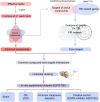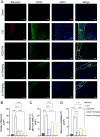A Novel Network Pharmacology Strategy Based on the Universal Effectiveness-Common Mechanism of Medical Herbs Uncovers Therapeutic Targets in Traumatic Brain Injury
- PMID: 38645986
- PMCID: PMC11032138
- DOI: 10.2147/DDDT.S450895
A Novel Network Pharmacology Strategy Based on the Universal Effectiveness-Common Mechanism of Medical Herbs Uncovers Therapeutic Targets in Traumatic Brain Injury
Abstract
Purpose: Many herbs can promote neurological recovery following traumatic brain injury (TBI). There must lie a shared mechanism behind the common effectiveness. We aimed to explore the key therapeutic targets for TBI based on the common effectiveness of the medicinal plants.
Material and methods: The TBI-effective herbs were retrieved from the literature as imputes of network pharmacology. Then, the active ingredients in at least two herbs were screened out as common components. The hub targets of all active compounds were identified through Cytohubba. Next, AutoDock vina was used to rank the common compound-hub target interactions by molecular docking. A highly scored compound-target pair was selected for in vivo validation.
Results: We enrolled sixteen TBI-effective medicinal herbs and screened out twenty-one common compounds, such as luteolin. Ten hub targets were recognized according to the topology of the protein-protein interaction network of targets, including epidermal growth factor receptor (EGFR). Molecular docking analysis suggested that luteolin could bind strongly to the active pocket of EGFR. Administration of luteolin or the selective EGFR inhibitor AZD3759 to TBI mice promoted the recovery of body weight and neurological function, reduced astrocyte activation and EGFR expression, decreased chondroitin sulfate proteoglycans deposition, and upregulated GAP43 levels in the cortex. The effects were similar to those when treated with the selective EGFR inhibitor.
Conclusion: The common effectiveness-based, common target screening strategy suggests that inhibition of EGFR can be an effective therapy for TBI. This strategy can be applied to discover core targets and therapeutic compounds in other diseases.
Keywords: AZD3759; astrocyte; epidermal growth factor receptor; luteolin; medicinal plants; traditional Chinese medicine.
© 2024 Yu et al.
Conflict of interest statement
The authors report no conflicts of interest in this work.
Figures







Similar articles
-
A real-world study and network pharmacology analysis of EGFR-TKIs combined with ZLJT to delay drug resistance in advanced lung adenocarcinoma.BMC Complement Med Ther. 2023 Nov 21;23(1):422. doi: 10.1186/s12906-023-04213-3. BMC Complement Med Ther. 2023. PMID: 37990309 Free PMC article.
-
Therapeutic effects of Siegesbeckia orientalis L. and its active compound luteolin in rheumatoid arthritis: network pharmacology, molecular docking and experimental validation.J Ethnopharmacol. 2023 Dec 5;317:116852. doi: 10.1016/j.jep.2023.116852. Epub 2023 Jun 28. J Ethnopharmacol. 2023. PMID: 37390879
-
[Mechanism of Ficus hirta-Hypericum perforatum in treatment of microvascular angina based on network pharmacology and molecular docking].Zhongguo Zhong Yao Za Zhi. 2021 Dec;46(24):6474-6483. doi: 10.19540/j.cnki.cjcmm.20210902.401. Zhongguo Zhong Yao Za Zhi. 2021. PMID: 34994140 Chinese.
-
Mechanism of Bazhen decoction in the treatment of colorectal cancer based on network pharmacology, molecular docking, and experimental validation.Front Immunol. 2023 Sep 20;14:1235575. doi: 10.3389/fimmu.2023.1235575. eCollection 2023. Front Immunol. 2023. PMID: 37799727 Free PMC article.
-
The potential mechanism of Bletilla striata in the treatment of ulcerative colitis determined through network pharmacology, molecular docking, and in vivo experimental verification.Naunyn Schmiedebergs Arch Pharmacol. 2023 May;396(5):983-1000. doi: 10.1007/s00210-022-02370-9. Epub 2022 Dec 28. Naunyn Schmiedebergs Arch Pharmacol. 2023. PMID: 36576506 Free PMC article.
Cited by
-
Unveiling the common mechanisms and therapeutic targets of medicinal herbs in acute pancreatitis: a network pharmacology and experimental validation approach.Bioresour Bioprocess. 2025 Jul 30;12(1):82. doi: 10.1186/s40643-025-00925-1. Bioresour Bioprocess. 2025. PMID: 40736877 Free PMC article.
References
MeSH terms
Substances
LinkOut - more resources
Full Text Sources
Medical
Research Materials
Miscellaneous

